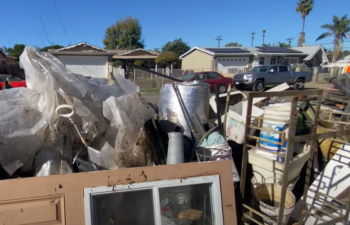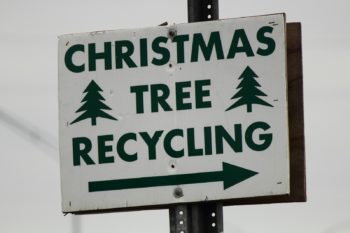They can hitchhike their way into a lake or reservoir in ballast water, attached to an anchor line, a boat hull, propellers, in bait buckets — or even microscopically in a single drop of water.
And once they arrive, they can spread devastation, multiplying so rapidly that they cover everything in sight and eating so voraciously that they suck all the life out of waterways — starving out fish, birds, eventually even themselves — and leaving nothing but dead water and massive cleanup costs.
Meet the quagga mussel. After never being seen anywhere near California, quaggas rode the Colorado River to Southern California in 2007. It’s a freshwater invader that has environmentalists, park rangers and water officials around the region asking boaters, water enthusiasts and the public to pitch in to the fight to keep them from spreading.
How?
“It’s really simple, ‘Clean, Drain and Dry; Don’t Move a Mussel,’” said Leigh Johnson, citing the mantra the California Department of Fish and Game and others have coined to stop the public — especially boaters — from moving, dripping wet and carrying quaggas with them, from one waterway to the next.
Johnson, coastal resources advisor with the UC Cooperative Extension/San Diego County Farm and Home Advisor, and Beryl Buchanan, supervising park ranger of the County’s Lake Morena Regional Park, said San Diego County has the most quagga infested sites in the entire state.
But they also said that fact makes it even more important for boaters and the public to help keep quaggas from spreading further.
“Not everywhere is infested,” Johnson said, “and boaters like to fish lots of different lakes. They can be carrying mussels to those new areas. And the more mussels you introduce, the greater you chance getting a problem you can’t fix.”
Buchanan said Lake Morena, a popular fishing spot, is the only County park that allows boats to launch. It’s also one of only four lakes and reservoirs left in the county that allow boat launchings that haven’t been infected with quaggas.
So County rangers thoroughly inspect every trailer and boat before allowing them into the water at Lake Morena. Boats can’t be wet at all (so you’re out of luck if you’ve rinsed your boat or it’s raining), and they can’t have any vegetation on them. Fishermen can’t even carry live bait because the water could carry “veligers,” the quagga’s microscopic larvae.
Buchanan said inspections usually take 10 minutes, “20 minutes tops,” but they still manage to irk some boaters.
But he said the alternative could be ending up like El Capitan Reservoir, where the shoreline, rocks and everything have become encrusted with quaggas. Buchanan and Johnson said shoreline shrubs in El Capitan became so covered by mussels that when they stick up out of the water they now look like “churros” — the thick, stick-like Spanish confection — “quagga-churros.”
Indigenous to Ukraine, quagga mussels were first found in the U.S. in the Great Lakes in the late 1980s, where their cleanup has cost billions of dollars. Scientists believe they were brought in the ballast water of European ships. In 2007, quagga larvae were found in reservoirs of the Colorado River and quickly spread south to Southern California down the Colorado River Aqueduct.
Quaggas are roundish and are often the size of a fingernail, but can be as large as a silver dollar or so small they “feel like sandpaper.” They have no natural predators in this part of the world. A single female can lay up to 1 million eggs in a season. They attach themselves to all types of surfaces: boats, docks, vegetation, can clog engines, pipeline and filter openings, pumping equipment and filter screens.
They also eat like crazy. Quaggas are “filter-feeders,” meaning they eat phytoplankton and suspended particles by sifting it out of the water they suck in. They actually alter ecosystems by eating all the food out of the water that would normally sustain native fish and birds. And their waste, which contains phosphorus, can make water smell and taste bad.
Scientists have researched numerous ways to control the pest, from superchlorination to using electricity and even sonic shocks. But for now, “Clean, Drain and Dry; Don’t Move a Mussel,” is the best advice.
“The more prevention we can do, the better,” Johnson said.
Here’s a list of actions that boaters can take to help prevent spreading the quagga mussel, from California’s Department of Fish and Game:
- Physically inspect all exposed surfaces of your boat or watercraft. Very small quagga/zebra mussels will feel like sandpaper to the touch. Remove aquatic plants from watercraft, motor, and trailer.
- Check all underwater fittings and equipment, such as rollers, axle, bilge, and trailer, and above water equipment, such as anchors, and, live wells. Dispose of aquatic plants in the trash.
- Throw away unused live bait in the trash.
- For personal watercraft, impeller areas can contain quagga/zebra mussels and aquatic plants. Once on the trailer, run the engine for five to 10 seconds to blow out excess water, mussels and plants.
- Drain all water from the watercraft including from the motor, bilges, live wells, and bait buckets.
- Thoroughly wash the hull and all water tanks. This is especially important if the watercraft has been moored for more than a day.
- Preferably wash with a hot water, high-pressure hose, but if unavailable any potable water source is better than nothing.
- If a trailer was used to remove the watercraft from the water, thoroughly wash the trailer as well.
- Drain all wash water and dry the watercraft and trailer.
- Watercraft should remain dry and out of water for a minimum of five days or longer between launches.
- Exercise patience at watercraft inspections. If you have followed these steps you have improved the likelihood you will breeze through an inspection.
For more information about quagga mussels and the steps you can take to prevent their spread, visit the California Department of Fish and Game’s quagga mussel Web page.





